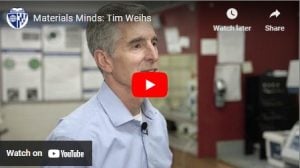Timothy Weihs, a professor of materials science and engineering, focuses on the fabrication, characterization, and application of reactive, structural, and biodegradable materials. He is driven by an interest in developing an understanding of how novel processing and chemistries can deliver unique microstructures and properties for scientific studies and specific applications.
In the area of reactive materials, Weihs began by developing sputter-deposited, reactive multilayer foils as model materials for studying phase transformations and as local heat sources for soldering and brazing components. In 2002, he took a three-year leave of absence from Johns Hopkins to commercialize the foils as co-founder and CEO of Reactive NanoTechnologies (RNT). After selling the company in 2009, Weihs expanded his studies of energetic materials into reactive metal powders and structural energetic materials for bio and chem agent defeat. He now directs the Materials Science in Extreme Environments University Research Alliance (MSEE), which sponsors the research. His group fabricates powders by ball-milling, ultrasonic atomization, and sputter deposition to identify chemistries and microstructures that enhance their ignition and combustion properties.
In structural materials, Weihs leveraged thermal and mechanical processing methods to refine the microstructure of FeCo alloys for jet engine applications and then the microstructure and chemistry of Mg alloys for armor applications. Currently, his group is working with Professor Falk to identify the role that dislocations and vacancies play in enhancing solute clustering and precipitate formation in Mg and Al alloys. He is also working within the Center on Artificial Intelligence for Materials in Extreme Environments (CAIMEE) to accelerate the development of novel metallic alloys.
For biomaterials, Weihs and his students are working with multiple partners to develop magnesium alloys for biodegradable medical implants. Examples of implants include screws and plates for bone fixation and porous scaffolds for filling bone defects. In all cases, they seek to identify the links between chemistry, microstructure, mechanical properties, and corrosion rates so that the implants degrade safely in the body while providing sufficient structural support until the bones heal. Part of this effort involves using 3D weaving and additive manufacturing to create novel architected materials with enhanced permeability and stiffness.
Weihs is a member of the Materials Research Society; The Minerals, Metals and Materials Society; and a fellow of the American Society for Metals. His awards include an NSF Career Award, a 3M Young Faculty Fellowship, an R&D 100 Award, an Innovator of the Year Award, the TMS Application to Practice Award, induction into the National Academy of Inventors, and a Fulbright Fellowship.
Weihs received a bachelor’s degree from Dartmouth College, then earned bachelor’s and master’s degrees in engineering from the Thayer School of Engineering. He received a PhD in materials science and engineering from Stanford University before conducting postdoctoral research at Oxford University in England and at the Lawrence Livermore National Laboratory in California. He joined the Johns Hopkins faculty in 1995, directed the Center for Leadership Education at Johns Hopkins from 2010 to 2017, and currently directs MSEE.



